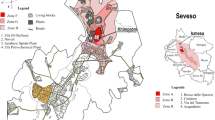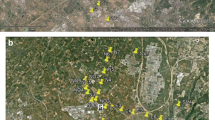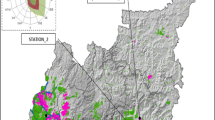Abstract
Significant dioxin (polychlorinated dibenzo-para-dioxins (PCDDs)/polychlorinated dibenzo-furans (PCDFs)) pollution from a municipal solid waste incinerator was discovered in 1997 in Osaka prefecture/Japan. The cause and mechanism of pollution was identified by a detailed assessment of the environment and incinerator plant. The primary sources of PCDD/PCDF pollution were high dioxin releases from an intermittently operated waste incinerator with PCDD/PCDF emissions of 150 ng-TEQ/Nm3. PCDD/PCDF also accumulated in the wet scrubber system (3,000 μg TEQ/L) by adsorption and water recirculation in the incinerator. Scrubber water was air-cooled with a cooling tower located on the roof of the incinerator. High concentrations of dioxins in the cooling water were released as aerosols into the surrounding and caused heavy soil pollution in the area near the plant. These emissions were considered as the major contamination pathway from the plant. Decontamination and soil remediation in and around the incinerator plant were conducted using a variety of destruction technologies (including incineration, photochemical degradation and GeoMelt technology). Although the soil remediation process was successfully finished in December 2006 about 3 % of the waste still remains. The case demonstrates that releases from incinerators which do not use best available technology or which are not operated according to best environmental practices can contaminate their operators and surrounding land. This significant pollution had a large impact on the Japanese government’s approach toward controlling dioxin pollution. Since this incident, a ministerial conference on dioxins has successfully strengthened control measures.






Similar content being viewed by others
Notes
In the public perception the largest PCDD/PCDF sources are waste incinerators. However the largest historic PCDD/PCDF releases stem from the organochlorine/chlorine industry (e.g. chlorine production, pesticide production and application) often associated with dioxin-contaminated sites (Weber et al. 2008; Götz et al. 2012; Torres et al. 2012).
References
Addink R, Olie K (1995) Mechanisms of formation and destruction of polychlorinated dibenzo-p-dioxins and dibenzofurans in heterogeneous systems. Environ Sci Technol 29:1425–1435
Committee for Dioxins Investigation around Toyono Clean Center (1997) The 1st report on Dioxins investigation in surrounding environment around Toyono Clean Center (in Japanese)
Committee for Dioxins Investigation around Toyono Clean Center (1998) The 2nd report on Dioxins investigation in surrounding environment around Toyono Clean Center (in Japanese)
Committee for Dioxins Issue in Toyono Clean Center (1999) Report on Dioxins issue in Toyono Clean Center (in Japanese)
DiGangi J, Petrlík J (2005) The egg report. International POPs Elimination Network (IPEN) http://english.arnika.org/ ipep/reports/GLOBAL_eggsreport.pdf
European Commission (2006) Reference Document on the Best Available Techniques for Waste Incineration, August 2006. ftp://ftp.jrc.es/pub/eippcb/doc/wi_bref_0806.pdf
EU (1999) Compilation of EU Dioxin Exposure and Health Data. Task 1—Member State Legislation and Programmes. Report produced for the European Commission DG Environment and the UK Department of the Environment, Transport and the Regions (DETR). AEAT/EEQC/0016.1 http://ec.europa.eu/environment/dioxin/pdf/task1.pdf
Former Environmental Agency of Japan (1998), Provisional manual for soil survey related to dioxins (in Japanese)
Former Environmental Agency of Japan (1999a), Emergency national survey of dioxin concentration in air, water, soil and aquatic organism (in Japanese)
Former Environmental Agency of Japan (1999b), The press release on selection results of soil remediation technologies for dioxins contamination on 25 Nov. 1999, retrieved in 15 August 2012 from http://www.env.go.jp/press/press.php?serial=2417 (in Japanese)
Former Ministry of Health and Welfare of Japan (1998), Dioxin concentration in municipal solid waste incinerator flue gas (in Japanese)
Former Ministry of Health and Welfare of Japan (1999), Report on verification test for treatment of highly-contaminated waste with dioxin (in Japanese)
Götz R, Sokollek V, Weber R (2012) The Dioxin/POPs legacy of pesticide production in Hamburg: Part 2: Waste deposits and remediation of Georgswerder landfill. Env Sci Pollut Res. DOI:10.1007/s11356-012-0986-x. http://www.springerlink.com/content/c5h6084587rm1j2j/fulltext.pdf
Government of Japan (1999) Law Concerning Special Measures Against Dioxins (the Dioxins Law) enacted in July 1999 entering into force January 15, 2000. http://www.env.go.jp/en/laws/chemi/dioxin.pdf
Hagenmaier H (1991) Destruction of PCDD and PCDF in refuse incineration plants by primary and secondary measures. Chemosphere 23:1429–1437
Holmes SJ, Jones KC, Miller CE (1994) PCDD/PCDF contamination of the environment at Bolsover UK. Organohalog Compd 24:373–377
Holmes SJ, Green N, Lohmann R, Jones KC (1998) Concentrations of PCDD/PCDFs in soil around a point source. Organohalog Compd 39:257–260
Horii Y., Sasaki T., Nakagawa K., Oshima K., Hanashima M. (2000) Decomposition of high concentration of dioxin in wastewater using photochemical degradation process, Proc. of 11th Annual Conf. Jpn Soc. Waste Manage Experts, 1062–1064 (in Japanese)
Hülster A, Marschner H (1993) Transfer of PCDD/PCDF from contaminated soils to food and fodder crop plants. Chemosphere 27:439–446
Investigative Commission on Dioxins Emission Mechanism & Japan Waste Research Foundation (1999) Investigative report on Dioxins emission mechanism (in Japanese)
Jeong T-U, Jeong J-E, Cho G-J, Cho E-J, Jeong S-R, Bin J-H, Cheigh H-S (2007) Levels of dioxin congeners in soil samples from various sites in Busan, Rep. of Korea. Organohalogen Compounds 69:1520–1523
Kitamura K, Kikuchi Y, Watanabe S, Waechter G, Sakurai H, Takada T (2000) Health effect of chronic exposure to PCDD, PCDF and coplanar PCB of municipal waste incinerator workers. Journal of Epidemiology 10:262–270
Konoike Construction Co. Ltd. Remediation of dioxins contaminated soil using TPS + GeoMelt method (in Japanese) http://www.konoike.co.jp/et/431/431_1.html accessed at 10 Sep.2010
Liem AKD, Hoogerbrugge R, Kootstra PR, van der Velde EG, de Jong APJM (1991) Occurance of dioxins in cows milk in the vicinity of municipal waste incinerators and a metal reclamation plant in The Netherlands. Chemosphere 23:1675–1684
Loethgren C-J, van Bavel (2005) Dioxin emissions after installation of a polishing wet scrubber in a hazardous waste incineration facility. Chemosphere 61:405–412
Masunaga S, Takasuga T, Nakanishi J (2001) Dioxin and dioxin-like PCB impurities in some Japanese agrochemical formulations. Chemosphere 44(4):873–885
Ministry of the Environment of Japan (2009) Annual lists of dioxin discharges 2008 (in Japanese)
Ministry of the Environment of Japan (2012) Waste management in Japan 2010 (in Japanese).
Malisch R, Gleadle A, Wright C (1999) PCDD/F in meat samples from domestic farm animals and game. Organohalogen Compd 43:265–268
Olie K, Vermeulen PL, Hutzinger O (1977) Chlorodibenzo-p-dioxins and chlorodibenzofurans are trace components in the Netherlands. Chemosphere 6:455–459
Osaka prefectural government (1999), Report on management of health risk caused by Dioxin
Pless-Mulloli T, Edwards R. Päpke O, Schilling B (2001) PCDD/PCDF and heavy metals in soil and egg samples from Newcastle allotments. Report by the University of Newcastle
Prinz B, Krause GHM, Radermacher L (1991) Criteria for the evaluation of dioxins in the environment. Chemosphere 23:1743–1761
Rideout K, Teschke K (2004) Potential for increased human foodborne exposure to PCDD/F when recycling sewage sludge on agricultural land. Environ Heal Perspect 112:959–969
Sakai S, Hiraoka M, Takeda N, Shiozaki K (1993) Coplanar PCBs and PCDDs/PCDFs in municipal waste incineration. Chemosphere 27:233–240
Sakurai T, Weber R, Ueno S, Nishino J, Tanaka M (2003) Relevance of coplanar-PCBs for TEQ emission of fluidized bed incineration and impact of emission control devices. Chemosphere 53:619–625
Stockholm Convention (2007) Guidelines on Best Available Techniques And Provisional Guidance On Best Environmental Practices Relevant To Article 5 And Annex C Of The Stockholm Convention On Persistent Organic Pollutants. http://chm.pops.int/Implementation/BATBEP/Guidelines/tabid/187/Default.aspx
Takata T (2003) Survey on the health effects of chronic exposure to dioxins and its accumulation on workers of a municipal solid waste incinerator, rural part of Osaka Prefecture, and the results of extended survey afterwards. Ind Heal 41:189–196
Tejima H, Nishigaki M, Fujita Y, Matsumoto A, Takeda N, Takaoka M (2007) Characteristics of dioxin emissions at startup and shutdown of MSW incinerators Chemosphere 66:1123–1130
UNEP (2005) Standardized toolkit for identification and quantification of dioxin and furan releases, 2nd edn. UNEP Chemicals, Geneva, Switzerland, February 2005. http://www.pops.int/documents/guidance/
Torres JPM, Leite C, Krauss T, Weber R (2012) Landfill mining from a deposit of the chlorine/organochlorine industry as source of dioxin contamination of animal feed and assessment of the responsible processes. Env Sci Pollut Res. doi:10.1007/s11356-012-1073-z
Watson A (2001) Comments on the ‘Report on the analysis of PCDD/PCDF and heavy metals in soil and egg samples related to the Byker incinerator’. http://www.greenpeace.org.uk/files/pdfs/migrated/MultimediaFiles/Live/FullReport/3188.pdf
Weber R, Hagenmaier H (1999) PCDD/PCDF formation in fluidized bed incineration. Chemosphere 38:2643–2654
Weber R, Iino F, Imagawa T, Takeuchi M, Sakurai T, Sadakata M (2001) Formation of PCDF, PCDD, PCB, and PCN in de novo synthesis from PAH: mechanisms and correlation to fluidized bed incinerators. Chemosphere 44:1429–1438
Weber R, Sakurai T (2002) Short term de novo formation of PCDD/PCDF and correlation to polychlorinated benzenes as surrogates. Organohalogen Compd 59:49–52
Weber R, Gaus C, Tysklind M, Johnston P, Forter M, Hollert H, Heinisch H, Holoubek I, Lloyd-Smith M, Masunaga S, Moccarelli P, Santillo D, Seike N, Symons R, Torres JPM, Verta M, Varbelow G, Vijgen J, Watson A, Costner P, Wölz J, Wycisk P, Zennegg M. Dioxin (2008) POP-contaminated sites—contemporary and future relevance and challenges. Env Sci Pollut Res 15, 363–393 http://www.springerlink.com/content/0q10km8582605r1x/fulltext.pdf
Yoshida H, Takahashi K, Takeda N, Sakai S (2009) Japan’s waste management policies for dioxins and polychlorinated biphenyls. J Mater Cycles Waste Manage 11:229–243
Acknowledgments
The authors would like to thank the Ministry of Health and Welfare (now Ministry of Environment), the Japan Waste Research Foundation, and the local government of Osaka Prefecture for the research programs, as well as many individuals for their cooperation.
Author information
Authors and Affiliations
Corresponding author
Additional information
Responsible editor: Philippe Garrigues
This article belongs to the series “Dioxin and POP Contaminated Sites” edited by Roland Weber, Mats Tysklind and Caroline Gaus (Weber et al. 2008).
Rights and permissions
About this article
Cite this article
Takeda, N., Takaoka, M. An assessment of dioxin contamination from the intermittent operation of a municipal waste incinerator in Japan and associated remediation. Environ Sci Pollut Res 20, 2070–2080 (2013). https://doi.org/10.1007/s11356-012-1412-0
Received:
Accepted:
Published:
Issue Date:
DOI: https://doi.org/10.1007/s11356-012-1412-0




